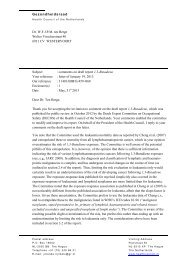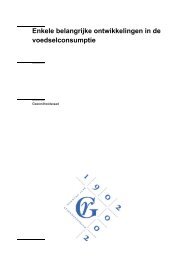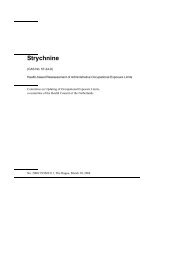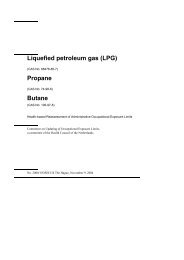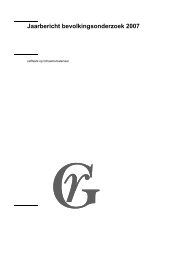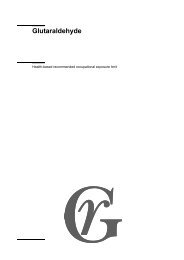1,2-Catechol (pyrocatechol) - Gezondheidsraad
1,2-Catechol (pyrocatechol) - Gezondheidsraad
1,2-Catechol (pyrocatechol) - Gezondheidsraad
Create successful ePaper yourself
Turn your PDF publications into a flip-book with our unique Google optimized e-Paper software.
1,2-<strong>Catechol</strong> (<strong>pyrocatechol</strong>)<br />
Evaluation of the carcinogenicity and genotoxicity
G e z o n d h e i d s r a a d<br />
H e a l t h C o u n c i l o f t h e N e t h e r l a n d s<br />
Aan de staatssecretaris van Sociale Zaken en Werkgelegenheid<br />
Onderwerp : aanbieding advies Pyrocatechol<br />
Uw kenmerk : DGV/MBO/U-932342<br />
Ons kenmerk : U 6373/JR/fs/246-O14<br />
Bijlagen : 1<br />
Datum : 25 februari 2011<br />
Geachte staatssecretaris,<br />
Graag bied ik u hierbij aan het advies over de gevolgen van beroepsmatige blootstelling aan<br />
<strong>pyrocatechol</strong>.<br />
Dit maakt deel uit van een uitgebreide reeks waarin kankerverwekkende stoffen worden<br />
geclassificeerd volgens richtlijnen van de Europese Unie. Het gaat om stoffen waaraan<br />
mensen tijdens de beroepsmatige uitoefening kunnen worden blootgesteld.<br />
Het advies is opgesteld door een vaste subcommissie van de Commissie Gezondheid en<br />
beroepsmatige blootstelling aan stoffen (GBBS), de Subcommissie Classificatie van carcinogene<br />
stoffen. Het advies is getoetst door de Beraadsgroep Gezondheid en omgeving van<br />
de <strong>Gezondheidsraad</strong>.<br />
Ik heb dit advies vandaag ter kennisname toegezonden aan de staatssecretaris van Infrastructuur<br />
en Milieu en aan de minister van Volksgezondheid, Welzijn en Sport.<br />
Met vriendelijke groet,<br />
prof. dr. L.J. Gunning-Schepers,<br />
voorzitter<br />
B e z o e k a d r e s<br />
P o s t a d r e s<br />
P a r n a s s u s p l e i n 5 P o s t b u s 1 6 0 5 2<br />
2 5 11 V X D e n H a a g 2 5 0 0 B B D e n H a a g<br />
Te l e f o o n ( 0 7 0 ) 3 4 0 6 6 3 1 Te l e f a x ( 0 7 0 ) 3 4 0 7 5 2 3<br />
E - m a i l : j m . r i j n k e l s @ g r . n l<br />
w w w . g r . n l
1,2-<strong>Catechol</strong> (<strong>pyrocatechol</strong>)<br />
Evaluation of the carcinogenicity and genotoxicity<br />
Subcommittee on the Classification of Carcinogenic Substances of<br />
the Dutch Expert Committee on Occupational Safety,<br />
a Committee of the Health Council of the Netherlands<br />
to:<br />
the State Secretary of Social Affairs and Employment<br />
No. 2011/05OSH, The Hague, February 25, 2011
The Health Council of the Netherlands, established in 1902, is an independent<br />
scientific advisory body. Its remit is “to advise the government and Parliament on<br />
the current level of knowledge with respect to public health issues and health<br />
(services) research...” (Section 22, Health Act).<br />
The Health Council receives most requests for advice from the Ministers of<br />
Health, Welfare & Sport, Infrastructure & the Environment, Social Affairs &<br />
Employment, Economic Affairs, Agriculture, & Innovation, and Education, Culture<br />
& Science. The Council can publish advisory reports on its own initiative. It<br />
usually does this in order to ask attention for developments or trends that are<br />
thought to be relevant to government policy.<br />
Most Health Council reports are prepared by multidisciplinary committees of<br />
Dutch or, sometimes, foreign experts, appointed in a personal capacity. The<br />
reports are available to the public.<br />
The Health Council of the Netherlands is a member of the European<br />
Science Advisory Network for Health (EuSANH), a network of science<br />
advisory bodies in Europe.<br />
INAHTA<br />
The Health Council of the Netherlands is a member of the International Network<br />
of Agencies for Health Technology Assessment (INAHTA), an international<br />
collaboration of organisations engaged with health technology assessment.<br />
This report can be downloaded from www.healthcouncil.nl.<br />
Preferred citation:<br />
Health Council of the Netherlands. 1,2-<strong>Catechol</strong> (<strong>pyrocatechol</strong>); Evaluation of<br />
the carcinogenicity and genotoxicity. The Hague: Health Council of the Netherlands,<br />
2011; publication no. 2011/05OSH.<br />
all rights reserved<br />
ISBN: 978-90-5549-829-1
Contents<br />
Samenvatting 7<br />
Executive summary 8<br />
1 Scope 9<br />
1.1 Background 9<br />
1.2 Committee and procedures 9<br />
1.3 Data 10<br />
2 General information 11<br />
2.1 Identity and physico-chemical properties 11<br />
2.2 IARC classification 12<br />
3 Carcinogenicity 13<br />
3.1 Observations in humans 13<br />
3.2 Carcinogenicity studies in animals 13<br />
4 Genotoxicity 16<br />
4.1 In vitro assays 16<br />
4.2 In vivo assays 18<br />
4.3 Carcinogenic mechanism of action 18<br />
Contents 5
Classification 20<br />
5.1 Evaluation of data on carcinogenesis and genotoxicity 20<br />
5.2 Recommendation for classification 21<br />
References 22<br />
Annexes 27<br />
A Request for advice 28<br />
B The Committee 30<br />
C Comments on the public review draft 32<br />
D IARC evaluation and conclusion 33<br />
E Mutagenicity and genotoxicity data 35<br />
F Carcinogenic classification of substances by the Committee 39<br />
G Regulation (EC) No 1272/2008 40<br />
Contents 6
Samenvatting<br />
Op verzoek van de minister van Sociale Zaken en Werkgelegenheid evalueert en<br />
beoordeelt de <strong>Gezondheidsraad</strong> de kankerverwekkende eigenschappen van stoffen<br />
waaraan mensen tijdens de beroepsmatige uitoefening kunnen worden blootgesteld.<br />
In het voorliggende advies neemt de subcommissie Classificatie van<br />
Carcinogene Stoffen van de Commissie Gezondheid en Beroepsmatige Blootstelling<br />
aan Stoffen van de Raad, die deze evaluatie en beoordeling verricht, 1,2-<br />
catechol (<strong>pyrocatechol</strong>) onder de loep. Pyrocatechol is een natuurlijke voorkomende<br />
stof die als grondproduct wordt gebruikt voor diverse doeleinden.<br />
Op basis van de beschikbare gegevens leidt de commissie af dat 1,2-catechol<br />
beschouwd moet worden als kankerverwekkend voor de mens en beveelt zij aan<br />
de stof te classificeren in categorie 1B * .<br />
Pyrocatechol kan werken via een stochastisch genotoxisch proces. Vanuit<br />
mechanistisch oogpunt verwacht de commissie dat <strong>pyrocatechol</strong> pas boven een<br />
bepaalde blootstelling een duidelijke meetbare bijdrage aan DNA-schade en dus<br />
aan het kankerrisico zal leveren. Op grond van de beschikbare gegevens kan echter<br />
geen blootstellingsniveau worden aangewezen waarop die bijdrage zichtbaar<br />
wordt.<br />
* Volgens het nieuwe classificatiesysteem van de <strong>Gezondheidsraad</strong> (zie bijlage F). Dit system is gebaseerd op richtlijn<br />
1272/2008 van de Europese Unie, die op 20 Januari 2009 van kracht werd.<br />
Samenvatting 7
Executive summary<br />
At request of the Minister of Social Affairs and Employment, the Health Council<br />
of the Netherlands evaluates and judges the carcinogenic properties of substances<br />
to which workers are occupationally exposed. The evaluation is performed<br />
by the subcommittee on Classifying Carcinogenic Substances of the<br />
Dutch Expert Committee on Occupational Safety of the Health Council. In this<br />
report, the Committee evaluated 1,2-catechol (<strong>pyrocatechol</strong>). Pyrocatechol is a<br />
natural occurring substance that is used for various purposes.<br />
Based on the available information, the Committee is of the opinion that 1,2-catechol<br />
is presumed to be carcinogenic to man, and recommends classifying the<br />
substance in category 1B * .<br />
Pyrocatechol is able to act by a stochastic genotoxic process. In view of the<br />
mechanism the Committee expects that <strong>pyrocatechol</strong> can contribute significantly<br />
to the DNA-damage, and thus to cancer risk, only above a certain exposure level.<br />
However, on the basis of the available data no exposure level can be determined<br />
at which the contribution becomes noticeable.<br />
* According to the new classification system of the Health Council (see Annex F), which is based on regulation<br />
1272/2008 of the European Union. This regulation entered into force on 20 January 2009.<br />
Executive summary 8
Chapter<br />
1<br />
Scope<br />
1.1 Background<br />
In the Netherlands a special policy is in force with respect to occupational use<br />
and exposure to carcinogenic substances. Regarding this policy, the Minister of<br />
Social Affairs and Employment has asked the Health Council of the Netherlands<br />
to evaluate the carcinogenic properties of substances, and to propose a classification<br />
(see Annex A). The assessment and the proposal for a classification are<br />
expressed in the form of standard sentences (see Annex F). The criteria used for<br />
classification are partly based on an EU-directive (see Annex G). In addition to<br />
classifying substances, the Health Council also assesses the genotoxic properties<br />
of the substance in question.<br />
This report contains the evaluation of the carcinogenicity of 1,2-catechol (<strong>pyrocatechol</strong>).<br />
1.2 Committee and procedures<br />
The evaluation is performed by the subcommittee on Classifying Carcinogenic<br />
Substances of the Dutch Expert Committee on Occupational Safety of the Health<br />
Council, hereafter called the Committee. The members of the Committee are<br />
listed in Annex B.<br />
Scope 9
1.3 Data<br />
In 2010 the President of the Health Council released a draft of the report for<br />
public review. The individuals and organisations that commented on the draft are<br />
listed in annex C. The Committee has taken these comments into account in<br />
deciding on the final version of the report.<br />
The evaluation and recommendation of the Committee is standardly based on<br />
scientific data, which are publicly available. The starting point of the Committees’<br />
report is, if possible, the monographs of the International Agency for<br />
Research on Cancer (IARC). This means that the original sources of the studies,<br />
which are mentioned in the IARC-monograph, are reviewed only by the Committee<br />
when these are considered most relevant in assessing the carcinogenicity<br />
and genotoxicity of the substance in question. In the case of <strong>pyrocatechol</strong>, such<br />
an IARC-monograph is available, of which the summary and conclusion of<br />
IARC is inserted in annex D.<br />
More recently published data were retrieved from the online databases<br />
Medline, Toxline, Chemical Abstracts, and RTECS. The last updated online<br />
search was in May 2010. The new relevant data were included in this report.<br />
Scope 10
Chapter<br />
2<br />
General information<br />
2.1 Identity and physico-chemical properties<br />
Pyrocatechol is a natural occurring plant polyphenol that is used as an ingredient<br />
for the production of insecticides, perfumes, and drugs. 26 It is furthermore used<br />
in photography, dyestuffs, electroplating, specialty inks, antioxidants and light<br />
stabilizers, and in organic synthesis. Other purposes are as a polymerization<br />
inhibitor, and as an antiseptic. It is also a metabolite of benzene.<br />
Occupational exposure may occur during manufacturing or packaging, or<br />
during use of the final products. The compound is present in fruits and vegetables<br />
as a natural compound. Therefore, regular consumption of low amounts of<br />
<strong>pyrocatechol</strong> is likely.<br />
Below is given the identity and some of its physico-chemical properties.<br />
Name : <strong>pyrocatechol</strong><br />
CAS no : 120-80-9 (CAS name, 1,2-benzenediol)<br />
EINECS no : 204-427-5<br />
EEC no : 604-016-00-4<br />
Synonyms : catechol; 1,2-dihydroxybenzene; o-dihydroxybenzene; catechine;<br />
pyrocatechine<br />
Description : colourless monoclinic crystals<br />
Occurrence : naturally in fruits and vegetables such as onions, apples, and crude<br />
beet sugar, and in trees such as pine, oak, and willow; it is present in<br />
cigarette smoke (100-360 µg/cigarette)<br />
Chemical formula : C 6 H 6 O 2<br />
General information 11
Chemical structure :<br />
Molecular weight : 110.11<br />
Boiling point (101.3 kPa) : 245 °C<br />
Melting point (101.3 kPa) : 105 °C<br />
Relative density (20°/4°C) : 1.344<br />
Vapour pressure (20°C) : 4 Pa<br />
Solubility : very soluble in water and aqueous alkalis; very soluble in benzene,<br />
chloroform, diethyl ether, ethanol, pyridine<br />
Log P oct/water : 0.88<br />
Conversion factors (101.3<br />
kPa; 20°C)<br />
: 1 ppm = 4.5 mg/m 3<br />
1 mg/m 3 = 0.22 ppm<br />
EU classification<br />
H312: harmful in contact with skin.<br />
H302: Harmful if swallowed.<br />
H319: Causes serious eye irritation.<br />
H315: Causes skin irritation.<br />
(Based on Regulation (EC) No 1272/2008 of the European Parliament<br />
and of the Council on Classification, labelling and packaging<br />
of substances and mixtures; 16 December 2008)<br />
2.2 IARC classification<br />
In 1999, IARC concluded that there is sufficient evidence for the carcinogenicity<br />
of <strong>pyrocatechol</strong> in experimental animals, but that there were no carcinogenicity<br />
data available from studies in humans. 26 Therefore, according to the IARC<br />
guidelines, it classified <strong>pyrocatechol</strong> in Group 2B, which means that the agent is<br />
possibly carcinogenic to humans.<br />
General information 12
Chapter<br />
3<br />
Carcinogenicity<br />
3.1 Observations in humans<br />
No data were available to evaluate the carcinogenicity of <strong>pyrocatechol</strong> in<br />
humans.<br />
3.2 Carcinogenicity studies in animals<br />
In the IARC monograph, various animal studies were evaluated, of which a summary<br />
is given below. 26<br />
Groups of Fischer rats and MRC-Wistar rats (n=30/group; males only) were<br />
given <strong>pyrocatechol</strong> in their drinking water at doses of 0 or 0.5% for 78 weeks, or<br />
were given the agent in their diet at doses of 0 or 2 mg/kg bw for up to 15 months<br />
(≈ 65 weeks). 30,37 In none of the studies <strong>pyrocatechol</strong> induced neoplasms. IARC<br />
noted the short durations of the studies. 26<br />
In two animal studies, performed independently from each other, male and<br />
female Fischer rats (n=30/group/sex), and Wistar, WKY, Lewis, and SD rats<br />
(n=20-30/group/strain; males only), were given <strong>pyrocatechol</strong> in their diet at a<br />
dose of 0.8% (w/w; final percentage in the diet) for 104 weeks (Hirose et al.<br />
1990, 1993; Tanaka et al. 1995). 21,22,26,50 In both studies and in all rat strains,<br />
consumption of <strong>pyrocatechol</strong>-enriched food caused a statistically significant<br />
increase in number of tumour-bearing animals compared to control animals<br />
receiving a normal diet. In all rat strains, adenomas, adenomatous hyperplasia, or<br />
Carcinogenicity 13
adenocarcinomas were found in the glandular stomach, while no such tumours<br />
were found in control animals. No other treatment-related effects were observed<br />
in any of the animals.<br />
Pathological effects in the glandular stomach were also reported in male and<br />
female B6C3F 1 mice (n=30/group/sex), which were fed a <strong>pyrocatechol</strong>-enriched<br />
diet (w/w; final concentration in diet, 0.8%) for 96 weeks (Hirose et al. 1990,<br />
1993). 21,22,26 The type of effects concerned adenomatous hyperplasia of both<br />
sexes, but no adenocarcinomas. Also, in the forestomach of both sexes, hyperplasia<br />
and papillomas were observed. No such pathological lesions were found in<br />
control animals receiving a normal diet. Furthermore, no other treatment-related<br />
effects were detected.<br />
More recently, Hagiwara et al. (2001) presented the results of a carcinogenicity<br />
study on Fischer rats (males only), which were given <strong>pyrocatechol</strong> in their<br />
diet. 16 Groups of thirty animals received dietary levels of 0, 0.1, 0.2, 0.4, and<br />
0.8% (w/w) <strong>pyrocatechol</strong> for 104 weeks. The average <strong>pyrocatechol</strong> intake was<br />
estimated to be 33, 65, 141, and 318 mg/kg bw/day. Five animals per group were<br />
sacrificed at week 34. Gross pathology at week 34 revealed slight thickening of<br />
the pyloric region of the stomach in the 0.4 and 0.8% groups, but not in the other<br />
groups. At termination of the study, the thickening was marked to moderate in<br />
the 0.2, 0.4 and the 0.8% groups. Concerning glandular stomachs, <strong>pyrocatechol</strong><br />
statistically significantly increased the number of animals with submucosal<br />
hyperplasia (all groups), and adenomas (all groups, except 0.1%). It also induced<br />
a non-significant increase in adenocarcinomas (0.4 and 0.8%). Furthermore, a<br />
dose-dependent increase in ulcerations was found. No neoplasms were found in<br />
control animals receiving normal diet. Neoplasms (squamous cell hyperplasia,<br />
papillomas) were also found in the forestomach, which reached statistical significance<br />
at 0.4 and 0.8% for squamous cell hyperplasia. In the lymph nodes surrounding<br />
the stomach, a statistically significant increase in cystic sinus dilatation<br />
was observed in 0.4 and 0.8% groups compared to control animals. Furthermore,<br />
in the 0.8% group a significant increase in number of animals with acinar cell<br />
adenomas in the pancreas were noted. The investigators did not find other treatment-related<br />
types of neoplasms.<br />
Van Duuren et al. (1986) and Melikian et al. (1989) topically applied <strong>pyrocatechol</strong><br />
on the skin of female SEN and Crl:DC-1 (1CR) BR mice (n=30/group),<br />
respectively. 26,36,53 The SEN mice received <strong>pyrocatechol</strong> at a dose of 0 or 2,000<br />
µg/animal, three times per week for 490-560 days (≈ 64-80 weeks); the other<br />
mice strain received a dose of 0 or 250 µg/animal, five times per week for 48<br />
Carcinogenicity 14
weeks. At the end of the experiments, no skin tumours were observed in any of<br />
the animals.<br />
IARC reported on several initiation-promotion studies to test <strong>pyrocatechol</strong> for its<br />
promotional potency. 26 In the majority of the studies Fischer F344 rats were<br />
used, which were given <strong>pyrocatechol</strong>-enriched diets (0.8 or 1.5% w/w) after a<br />
short initiation period with known carcinogens (i.e., nitrosoamines), but also<br />
other study designs were reported. In short, <strong>pyrocatechol</strong> enhanced tumour<br />
development in the stomach after tumour initiation (Hirose et al. 1987;<br />
Yamaguchi et al. 1989; Hagiwara et al. 1993; Hirose et al. 1993; Kawabe et al.<br />
1994). 17,24,25,27,57 Kobayashi et al. (1999) observed that administration of <strong>pyrocatechol</strong><br />
in the diet at low doses (4, 20, 100 and 500 ppm), did only enhance preneoplastic<br />
lesions, but not neoplastic lesions in the stomach of BALB/c mice,<br />
which received a tumour initiator earlier. 28 It also enhanced papillomas of the<br />
tongue, and carcinomas of the oesophagus (Hirose et al. 1987) 24 However, no<br />
tumour enhancement was observed regarding bladder tumours (Miyata et al.<br />
1985; Kurata et al. 1990; Fukushima et al. 1991) 13,29,38 , liver tumours (Stenius et<br />
al. 1989; Okazaki et al. 1993), 44,48 kidney tumours (Okazaki et al. 1993) 44 , and<br />
pancreatic tumours (Maruyama et al. 1994), 34 compared to treatments with the<br />
initiators alone, or with <strong>pyrocatechol</strong> alone.<br />
Carcinogenicity 15
Chapter<br />
4<br />
Genotoxicity<br />
The outcomes of the individual studies are given in Annex E.<br />
4.1 In vitro assays<br />
In bacterial reverse mutation assays, <strong>pyrocatechol</strong> did not induce gene mutations<br />
in various Salmonella typhimurium strains, in the presence or absence of a metabolic<br />
activation system. 11,18,19,26 No increased frequencies of mutations were<br />
observed in IC204, IC206, and IC208 E. coli strains, which are used to detect the<br />
induction of mutagens generated from 8-oxoguanine lesions. In the WP2 Mutoxitest,<br />
a test system to detect oxidative mutagenicity, <strong>pyrocatechol</strong> did induce<br />
reverse mutations in IC203 Escherichia coli strain, but only in the absence of a<br />
metabolic activation system (Martínez et al. 2000). 33 In the Mut-Test, a test system<br />
to detect substances, which prevent spontaneous mutations due to oxidative<br />
damage, <strong>pyrocatechol</strong> showed a dose-related antimutagenic activity in E. coli<br />
mutT mutants. 58 Regarding DNA damage and repair, <strong>pyrocatechol</strong> exposure did<br />
not induce DNA repair in S. typhimurium bacteria, in the presence or absence of<br />
a metabolic activation system.<br />
No gene conversions or homozygosis were found in the yeast Saccharomyces<br />
cerevisiae, in the absence of a metabolic activation system, while in the same<br />
yeast <strong>pyrocatechol</strong> induced forward mutations. 26 Sommers and Schiestl (2006)<br />
showed that <strong>pyrocatechol</strong> induced intrachromosomal recombinations in S. Cere-<br />
Genotoxicity 16
visiae strains RS112 and RS177, which are also used to detect DNA strand<br />
breaks. 47<br />
Using a 32 P-postlabelling technique, Oikawa et al. (2001) showed that <strong>pyrocatechol</strong><br />
dose-dependently increased DNA damage in calf thymus DNA. 43 Exposure<br />
of mammalian cells to <strong>pyrocatechol</strong> resulted in gene mutations at the tk locus of<br />
mouse L5178Y lymphoma cells, and at the hprt and Na+/K+ ATPase loci in Syrian<br />
hamster embryo cells. 26 No unscheduled DNA synthesis was observed in primary<br />
rat hepatocytes, which were exposed to <strong>pyrocatechol</strong> at a concentration of<br />
0.5 to 1000 µg/mL for approximately 24 hours. 9 Contradictory, unscheduled<br />
DNA synthesis was reported by Tsutsui et al. (1997) in Syrian hamster embryo<br />
cells. 51<br />
In the presence or absence of a metabolic activation system, in primary rat hepatocytes,<br />
and in human peripheral blood lymphocytes, exposure to <strong>pyrocatechol</strong><br />
caused a weak increase of DNA strand breaks. 26 However, test results with<br />
mouse lymphoma cells were equivocal. 12,26 The Committee noted that the test<br />
results might have been influenced by differences in the composition of the incubation<br />
media. For instance, Fabiani et al. (2001) reported on DNA damage<br />
induced by <strong>pyrocatechol</strong> in human peripheral blood lymphocytes, which were<br />
incubated in four different media. 7 Only in the so-called PBS media in the<br />
absence of foetal calf’s serum, DNA damage was statistically significantly<br />
increased compared to non-treated cells, while in media (PBS and RPMI) in the<br />
presence of serum no treatment-related DNA damage could be observed. Pyrocatechol<br />
also induced chromosomal aberrations in Syrian hamster embryo cells,<br />
and micronuclei and chromosomal loss in human lymphocytes. However, in at<br />
least one study, no micronuclei could be detected in the latter type of cells (Robertson<br />
et al. 1991). 46 Do Céu Silva et al. (2003) reported on a pH-dependent<br />
increase in frequencies of chromosomal aberrations in Chinese hamster V79<br />
fibroblasts. 5 Using a human lymphoid cell line, Stillman et al. (1999) could<br />
detect aneuploidy, when <strong>pyrocatechol</strong> was given in combination with hydroquinone,<br />
but not when the substances were given alone. 49 Pyrocatechol exposure<br />
increased frequencies of sister chromatid exchanges in Syrian hamster embryo<br />
cells, and in human lymphocytes. 26<br />
De Oliveira et al. (2010) showed that <strong>pyrocatechol</strong> induced apoptosis in<br />
human glioblastoma GL-15 cells (Comet assay; exposure up to 600 µM for 48<br />
hours). 4<br />
Genotoxicity 17
4.2 In vivo assays<br />
A day after a single dose of 25 mg <strong>pyrocatechol</strong>/mL was given (by means of a<br />
glass filter paper, saturated with a solution of the compound), no increased frequencies<br />
of sex-linked recessive lethal mutations in male Drosophila melanogaster<br />
flies were observed. 2 Pyrocatechol did induce DNA repair in E. Coli<br />
(host-mediated assay) in mice. In the glandular stomach epithelium of rats,<br />
which were given <strong>pyrocatechol</strong> in their diet (0.8%) for two weeks, no clear<br />
increase in DNA adducts was observed. 23 In somatic cells, no (gene) mutations<br />
were observed in a mouse spot test. 26<br />
Regarding clastogenicity and aneuploidy, IARC reported in its monograph of a<br />
few studies, in which <strong>pyrocatechol</strong> induced micronuclei in CD-1 mice after a single<br />
oral or intraperitoneal administration, but not in NMRI mice after repeated<br />
subcutaneous administration. 26 In bone marrow cells of male Sprague-Dawley<br />
rats (n=15/group), which were given a single dose of 0, 10, 30, or 100 mg <strong>pyrocatechol</strong>/kg<br />
bw by gavage, no differences in frequencies of chromosomal aberration,<br />
mean chromosomal numbers, and mean mitotic indices were found<br />
compared to non-treated animals. 9 Furthermore, a single oral administration of<br />
<strong>pyrocatechol</strong> to Fischer F344 rats did not result in DNA strand breaks or cross<br />
links in the pyloric mucosa of the stomach. 26<br />
4.3 Carcinogenic mechanism of action<br />
The mechanism through which <strong>pyrocatechol</strong> may show carcinogenic potential is<br />
still not fully understood. Both stochastic genotoxic as well as non-genotoxic<br />
mechanisms are likely to play a role.<br />
A common hypothesis is that <strong>pyrocatechol</strong> induces oxidative DNA damage.<br />
It is for instance speculated that in aqueous environment (pH around or above<br />
neutrality) <strong>pyrocatechol</strong> undergoes Cu 2+ -mediated autoxidation to generate Cu +<br />
and semiquinone radicals. 5,43 Binding of Cu + to oxygen generates reactive oxygen<br />
species, but also reduction of semiquinone radicals into 1,2-benzoquinone<br />
may do so. 26,31 These reactive oxygen species may ultimately lead to DNA damage.<br />
About the type of reactive oxygen species and type of oxidative DNA damage,<br />
these are of the same type as generated by cells during normal cellular processes.<br />
Under normal conditions, the antioxidant defense system within the cell<br />
can easily handle the free oxygen radicals produced. Based on this knowledge,<br />
Genotoxicity 18
the Committee expects that reactive oxygen species, which are generated by<br />
<strong>pyrocatechol</strong> at the lowest exposure levels, disappear in the pool of endogenous<br />
oxygen species, and are removed efficiently by the oxidant defense system.<br />
However, at increasing exposure a breaking point will be reached, at which the<br />
defense system gets exhausted. From that moment on, the Committee expects<br />
that the <strong>pyrocatechol</strong>-generated reactive oxygen species will contribute greatly to<br />
the oxidative DNA damage, and thus to the risk of cancer development. In terms<br />
of quantitative risk analysis, this would indicate that a threshold level exists, at or<br />
below which the risk of cancer is expected not to exceed the background risk.<br />
Yet, formation of reactive oxygen species might not explain all positive outcomes<br />
of the genotoxicity studies in vitro. For instance, The presence of antioxidant<br />
enzymes, such as superoxide dismutase and catalase, should remove<br />
reactive oxygen species resulting in reduced DNA damage, but so far these<br />
enzymes did not clearly influence <strong>pyrocatechol</strong>-induced DNA damage in<br />
vitro. 5,43 Further research is needed to clarify these findings.<br />
The Committee cannot exclude that <strong>pyrocatechol</strong> may exert its carcinogenic<br />
effect by its irritating potency, a nongenotoxic mechanism. Pyrocatechol was<br />
found to irritate the skin and eyes, the respiratory and gastrointestinal tract of<br />
humans; and, the skin and eyes of guinea pigs. 31 Chronic exposure to irritants<br />
may induce continuous cell proliferation, making the cells prone to DNA damage.<br />
However, so far known, no evidence is available that can confirm the validity<br />
of this hypothesis.<br />
Genotoxicity 19
Chapter<br />
5<br />
Classification<br />
5.1 Evaluation of data on carcinogenesis and genotoxicity<br />
No data on the genotoxicity and carcinogenicity of <strong>pyrocatechol</strong> in humans were<br />
available. In several animal carcinogenicity studies, chronic administration of<br />
<strong>pyrocatechol</strong> in the diet caused an increased number of tumour-bearing male and<br />
female animals with neoplasms in the glandular stomach (and forestomach).<br />
However, no tumours were found in other organs than the stomach when <strong>pyrocatechol</strong><br />
was given alone, or after a tumour-initiation period with known carcinogenic<br />
initiators. The findings of the animal studies give sufficient evidence that<br />
exposure to <strong>pyrocatechol</strong> can result in cancer development, at least in animals.<br />
The results of the available genotoxicity tests indicate that <strong>pyrocatechol</strong> can<br />
be considered as an in vitro genotoxic compound, inducing predominantly clastogenic<br />
effects. Studies also show that <strong>pyrocatechol</strong> is able to induce oxidative<br />
DNA damage by a stochastic genotoxic mechanism. The Committee further<br />
noted that except for one mouse study, all other in vivo studies were negative;<br />
therefore the Committee considers that in vivo results as ambiguous at worst.<br />
Pyrocatechol is metabolized efficiently by conjugation (sulfation and glucuronidation)<br />
at its phenol groups. At higher concentrations, redox cycling may<br />
generate reactive oxygen species at an appreciable extent. These reactive oxygen<br />
species are of the same type as those generated by normal cellular processes.<br />
Therefore, they are expected to enter the pool of reactive oxygen species generated<br />
by endogenous metabolism and to be handled accordingly by the natural<br />
Classification 20
antioxidant defense system. At (very) low exposure levels of <strong>pyrocatechol</strong>, no<br />
significant contribution to the endogenous pool of reactive oxygen species is<br />
expected. In addition, at those low exposure levels, DNA damage induced by<br />
<strong>pyrocatechol</strong>-generated reactive oxygen species will not noticeably increase<br />
DNA damage already caused by endogenous reactive oxygen species. This<br />
implies that only above a certain exposure level <strong>pyrocatechol</strong> contributes significantly<br />
to the DNA damage, and thus to cancer risk. However, on the basis of the<br />
available data on <strong>pyrocatechol</strong> no exposure level (‘threshold’) can be determined<br />
at which the contribution becomes noticeable.<br />
The Committee is of the opinion that the observations in animals, and the<br />
proposed carcinogenic mechanism are relevant also to humans.<br />
5.2 Recommendation for classification<br />
The Committee is of the opinion that 1,2-catechol (<strong>pyrocatechol</strong>) is presumed to<br />
be carcinogenic to man, and recommends to classify the substance in category<br />
1B * .<br />
Pyrocatechol is able to act by a stochastic genotoxic mechanism. In view of<br />
the mechanism the Committee expects that <strong>pyrocatechol</strong> can contribute significantly<br />
to the DNA-damage, and thus to cancer risk, only above a certain exposure<br />
level. However, on the basis of the available data no exposure level can be<br />
determined at which the contribution becomes noticeable.<br />
* According to the new classification system of the Health Council (see Annex F), which is based on regulation<br />
1272/2008 of the European Union (see Annex G). This regulation entered into force on 20 January 2009.<br />
Classification 21
References<br />
1 Anderson D, Yu TW, Schmezer P. An investigation of the DNA-damaging ability of benzene and its<br />
metabolites in human lymphocytes, using the comet assay. Environ Mol Mutagen 1995; 26(4): 305-<br />
314.<br />
2 Benson E, Myhr B. Mutagenicity evaluation of FMC 65357 technical (catechol) FMS study no. A83-<br />
1151 in the sex-linked recessive lethal test in Drosophila melanogaster. Kensington MD, USA: Litton<br />
Bionetics, Inc, EPA/OTS0572939; 1984: LBI project No. 22205.<br />
3 Ciranni R, Barale R, Ghelardini G, Loprieno N. Benzene and the genotoxicity of its metabolites. II.<br />
The effect of the route of administration on the micronuclei and bone marrow depression in mouse<br />
bone marrow cells. Mutat Res 1988; 209(1-2): 23-28.<br />
4 de Oliveira DM, Pitanga BP, Grangeiro MS, Lima RM, Costa MF, Costa SL e.a. <strong>Catechol</strong><br />
cytotoxicity in vitro: induction of glioblastoma cell death by apoptosis. Hum Exp Toxicol 2010;<br />
29(3): 199-212.<br />
5 do Ceu SM, Gaspar J, Silva ID, Leao D, Rueff J. Induction of chromosomal aberrations by phenolic<br />
compounds: possible role of reactive oxygen species. Mutat Res 2003; 540(1): 29-42.<br />
6 Erexson GL, Wilmer JL, Kligerman AD. Sister chromatid exchange induction in human lymphocytes<br />
exposed to benzene and its metabolites in vitro. Cancer Res 1985; 45(6): 2471-2477.<br />
7 Fabiani R, De Bartolomeo A, Rosignoli P, Scamosci M, Lepore L, Morozzi G. Influence of culture<br />
conditions on the DNA-damaging effect of benzene and its metabolites in human peripheral blood<br />
mononuclear cells. Environ Mol Mutagen 2001; 37(1): 1-6.<br />
8 Fahrig R. Genetic mode of action of cocarcinogens and tumor promoters in yeast and mice. Mol Gen<br />
Genet 1984; 194(1-2): 7-14.<br />
References 22
9 Farrow M, Cortina T. In vivo bone marrow chromosome study in rats with FMC 65357 (catechol),<br />
final report A83-858. Vienna VA, USA: Hazleton Laboratories America, Inc.; 1984: order no.<br />
OTS0572938.<br />
10 Farrow M, Draus M. Mouse lymphoma forward mutation assay with catechol. Kensington MD,<br />
USA: Litton Bionetics, Inc; 1983: order no. OTS0572939.<br />
11 Farrow M, McCarrol N. Two final reports and eight mutagenicity studies on catechol. Vienna VA,<br />
USA: Hazleton Laboratories America, Inc.; 1984: order no. OTS0000637-2.<br />
12 Farrow M, Sernau R. Unscheduled DNA synthesis - rat hepatocyte assay of FMC 65357, batch E<br />
2128-134, study number A38-856. Vienna VA, USA: Hazleton Laboratories America, Inc.; 1983:<br />
order no. OTS0572936.<br />
13 Fukushima S, Hagiwara A, Hirose M, Yamaguchi S, Tiwawech D, Ito N. Modifying effects of<br />
various chemicals on preneoplastic and neoplastic lesion development in a wide-spectrum organ<br />
carcinogenesis model using F344 rats. Jpn J Cancer Res 1991; 82(6): 642-649.<br />
14 Furihata C, Hatta A, Matsushima T. Inductions of ornithine decarboxylase and replicative DNA<br />
synthesis but not DNA single strand scission or unscheduled DNA synthesis in the pyloric mucosa of<br />
rat stomach by catechol. Jpn J Cancer Res 1989; 80(11): 1052-1057.<br />
15 Garberg P, Akerblom EL, Bolcsfoldi G. Evaluation of a genotoxicity test measuring DNA-strand<br />
breaks in mouse lymphoma cells by alkaline unwinding and hydroxyapatite elution. Mutat Res 1988;<br />
203(3): 155-176.<br />
16 Hagiwara A, Takesada Y, Tanaka H, Tamano S, Hirose M, Ito N e.a. Dose-dependent induction of<br />
glandular stomach preneoplastic and neoplastic lesions in male F344 rats treated with catechol<br />
chronically. Toxicol Pathol 2001; 29(2): 180-186.<br />
17 Hagiwara A, Tanaka H, Imaida K, Tamano S, Fukushima S, Ito N. Correlation between medium-term<br />
multi-organ carcinogenesis bioassay data and long-term observation results in rats. Jpn J Cancer Res<br />
1993; 84(3): 237-245.<br />
18 Haworth S, Lawlor T, Burke J, Olewine S, Plunkett R, Coyle L. Two final reports and eight<br />
mutagenicity studies on catechol, study no. T2013.501. Bethesda MD, USA: Microbiological<br />
Associates; 1983: order no. OTS0000637-2.<br />
19 Haworth S, Olewine S, Burke J, Lawlor T, Plunkett R, Kott S. Two final reports and eight<br />
mutagenicity studies on catechol, study number T1957.501006 - T1962.501006. Bethesda MD, USA:<br />
Microbiological Associates; 1983: order no. OTS0000637-2.<br />
20 Hellmer L, Bolcsfoldi G. An evaluation of the E. coli K-12 uvrB/recA DNA repair host-mediated<br />
assay. II. In vivo results for 36 compounds tested in the mouse. Mutat Res 1992; 272(2): 161-173.<br />
21 Hirose M, Fukushima S, Shirai T, Hasegawa R, Kato T, Tanaka H e.a. Stomach carcinogenicity of<br />
caffeic acid, sesamol and catechol in rats and mice. Jpn J Cancer Res 1990; 81(3): 207-212.<br />
22 Hirose M, Fukushima S, Tanaka H, Asakawa E, Takahashi S, Ito N. Carcinogenicity of catechol in<br />
F344 rats and B6C3F1 mice. Carcinogenesis 1993; 14(3): 525-529.<br />
References 23
23 Hirose M, Hakoi K, Takahashi S, Hoshiya T, Akagi K, Lin C e.a. Sequential morphological and<br />
biological changes in the glandular stomach induced by oral administration of catechol to male F344<br />
rats. Toxicol Pathol 1999; 27(4): 448-455.<br />
24 Hirose M, Kurata Y, Tsuda H, Fukushima S, Ito N. <strong>Catechol</strong> strongly enhances rat stomach<br />
carcinogenesis: a possible new environmental stomach carcinogen. Jpn J Cancer Res 1987; 78(11):<br />
1144-1149.<br />
25 Hirose M, Tanaka H, Takahashi S, Futakuchi M, Fukushima S, Ito N. Effects of sodium nitrite and<br />
catechol, 3-methoxycatechol, or butylated hydroxyanisole in combination in a rat multiorgan<br />
carcinogenesis model. Cancer Res 1993; 53(1): 32-37.<br />
26 IARC. <strong>Catechol</strong>. IARC Monogr Eval Carcinog Risks Hum 1999; 71 Pt 2: 433-451.<br />
27 Kawabe M, Takaba K, Yoshida Y, Hirose M. Effects of combined treatment with phenolic<br />
compounds and sodium nitrite on two-stage carcinogenesis and cell proliferation in the rat stomach.<br />
Jpn J Cancer Res 1994; 85(1): 17-25.<br />
28 Kobayashi K, Inada K, Furihata C, Tsukamoto T, Ikehara Y, Yamamoto M e.a. Effects of low dose<br />
catechol on glandular stomach carcinogenesis in BALB/c mice initiated with N-methyl-Nnitrosourea.<br />
Cancer Lett 1999; 139(2): 167-172.<br />
29 Kurata Y, Fukushima S, Hasegawa R, Hirose M, Shibata M, Shirai T e.a. Structure-activity relations<br />
in promotion of rat urinary bladder carcinogenesis by phenolic antioxidants. Jpn J Cancer Res 1990;<br />
81(8): 754-759.<br />
30 La Voie EJ, Shigematsu A, Mu B, Rivenson A, Hoffmann D. The effects of catechol on the urinary<br />
bladder of rats treated with N-butyl-N-(4-hydroxybutyl)nitrosamine. Jpn J Cancer Res 1985; 76(4):<br />
266-271.<br />
31 Lundberg P. Consensus report for catechol. In: Scientific basis for Swedish occupational standards<br />
XIII. Solna, Sweden: National Institute of Occupational Health; 1992: Arbete och Hälsa 1992:47.<br />
32 Marrazzini A, Chelotti L, Barrai I, Loprieno N, Barale R. In vivo genotoxic interactions among three<br />
phenolic benzene metabolites. Mutat Res 1994; 341(1): 29-46.<br />
33 Martinez A, Urios A, Blanco M. Mutagenicity of 80 chemicals in Escherichia coli tester strains<br />
IC203, deficient in OxyR, and its oxyR(+) parent WP2 uvrA/pKM101: detection of 31 oxidative<br />
mutagens. Mutat Res 2000; 467(1): 41-53.<br />
34 Maruyama H, Amanuma T, Tsutsumi M, Tsujiuchi T, Horiguchi K, Denda A e.a. Inhibition by<br />
catechol and di(2-ethylhexyl)phthalate of pancreatic carcinogenesis after initiation with N-<br />
nitrosobis(2-hydroxypropyl)amine in Syrian hamsters. Carcinogenesis 1994; 15(6): 1193-1196.<br />
35 McGregor DB, Riach CG, Brown A, Edwards I, Reynolds D, West K e.a. Reactivity of<br />
catecholamines and related substances in the mouse lymphoma L5178Y cell assay for mutagens.<br />
Environ Mol Mutagen 1988; 11(4): 523-544.<br />
36 Melikian AA, Jordan KG, Braley J, Rigotty J, Meschter CL, Hecht SS e.a. Effects of catechol on the<br />
induction of tumors in mouse skin by 7,8-dihydroxy-7,8-dihydrobenzo[a]pyrenes. Carcinogenesis<br />
1989; 10(10): 1897-1900.<br />
References 24
37 Mirvish SS, Salmasi S, Lawson TA, Pour P, Sutherland D. Test of catechol, tannic acid, Bidens<br />
pilosa, croton oil, and phorbol for cocarcinogenesis of esophageal tumors induced in rats by methyln-amylnitrosamine.<br />
J Natl Cancer Inst 1985; 74(6): 1283-1290.<br />
38 Miyata Y, Fukushima S, Hirose M, Masui T, Ito N. Short-term screening of promoters of bladder<br />
carcinogenesis in N-butyl-N-(4-hydroxybutyl)nitrosamine-initiated, unilaterally ureter-ligated rats.<br />
Jpn J Cancer Res 1985; 76(9): 828-834.<br />
39 Morimoto K. Induction of sister chromatid exchanges and cell division delays in human lymphocytes<br />
by microsomal activation of benzene. Cancer Res 1983; 43(3): 1330-1334.<br />
40 Morimoto K, Wolff S. Cell cycle kinetics in human lymphocyte cultures. Nature 1980; 288(5791):<br />
604-606.<br />
41 Nakamura SI, Oda Y, Shimada T, Oki I, Sugimoto K. SOS-inducing activity of chemical carcinogens<br />
and mutagens in Salmonella typhimurium TA1535/pSK1002: examination with 151 chemicals.<br />
Mutat Res 1987; 192(4): 239-246.<br />
42 Nazar MA, Rapson WH, Brook MA, May S, Tarhanen J. Mutagenic reaction products of aqueous<br />
chlorination of catechol. Mutat Res 1981; 89(1): 45-55.<br />
43 Oikawa S, Hirosawa I, Hirakawa K, Kawanishi S. Site specificity and mechanism of oxidative DNA<br />
damage induced by carcinogenic catechol. Carcinogenesis 2001; 22(8): 1239-1245.<br />
44 Okazaki S, Hoshiya T, Takahashi S, Futakuchi M, Saito K, Hirose M. Modification of hepato- and<br />
renal carcinogenesis by catechol and its isomers in rats pretreated with N-ethyl-Nhydroxyethylnitrosamine.<br />
Teratog Carcinog Mutagen 1993; 13(3): 127-137.<br />
45 Pellack-Walker P, Blumer JL. DNA damage in L5178YS cells following exposure to benzene<br />
metabolites. Mol Pharmacol 1986; 30(1): 42-47.<br />
46 Robertson ML, Eastmond DA, Smith MT. Two benzene metabolites, catechol and hydroquinone,<br />
produce a synergistic induction of micronuclei and toxicity in cultured human lymphocytes. Mutat<br />
Res 1991; 249(1): 201-209.<br />
47 Sommers CH, Schiestl RH. Effect of benzene and its closed ring metabolites on intrachromosomal<br />
recombination in Saccharomyces cerevisiae. Mutat Res 2006; 593(1-2): 1-8.<br />
48 Stenius U, Warholm M, Rannug A, Walles S, Lundberg I, Hogberg J. The role of GSH depletion and<br />
toxicity in hydroquinone-induced development of enzyme-altered foci. Carcinogenesis 1989; 10(3):<br />
593-599.<br />
49 Stillman WS, Varella-Garcia M, Irons RD. The benzene metabolites hydroquinone and catechol act<br />
in synergy to induce dose-dependent hypoploidy and -5q31 in a human cell line. Leuk Lymphoma<br />
1999; 35(3-4): 269-281.<br />
50 Tanaka H, Hirose M, Hagiwara A, Imaida K, Shirai T, Ito N. Rat strain differences in catechol<br />
carcinogenicity to the stomach. Food Chem Toxicol 1995; 33(2): 93-98.<br />
51 Tsutsui T, Hayashi N, Maizumi H, Huff J, Barrett JC. Benzene-, catechol-, hydroquinone- and<br />
phenol-induced cell transformation, gene mutations, chromosome aberrations, aneuploidy, sister<br />
chromatid exchanges and unscheduled DNA synthesis in Syrian hamster embryo cells. Mutat Res<br />
1997; 373(1): 113-123.<br />
References 25
52 Tunek A, Hogstedt B, Olofsson T. Mechanism of benzene toxicity. Effects of benzene and benzene<br />
metabolites on bone marrow cellularity, number of granulopoietic stem cells and frequency of<br />
micronuclei in mice. Chem Biol Interact 1982; 39(2): 129-138.<br />
53 Duuren BL van, Melchionne S, Seidman I. Phorbol myristate acetate and catechol as skin<br />
cocarcinogens in SENCAR mice. Environ Health Perspect 1986; 68: 33-38.<br />
54 Walles SA. Mechanisms of DNA damage induced in rat hepatocytes by quinones. Cancer Lett 1992;<br />
63(1): 47-52.<br />
55 Wangenheim J, Bolcsfoldi G. Mouse lymphoma L5178Y thymidine kinase locus assay of 50<br />
compounds. Mutagenesis 1988; 3(3): 193-205.<br />
56 Yager JW, Eastmond DA, Robertson ML, Paradisin WM, Smith MT. Characterization of micronuclei<br />
induced in human lymphocytes by benzene metabolites. Cancer Res 1990; 50(2): 393-399.<br />
57 Yamaguchi S, Hirose M, Fukushima S, Hasegawa R, Ito N. Modification by catechol and resorcinol<br />
of upper digestive tract carcinogenesis in rats treated with methyl-N-amylnitrosamine. Cancer Res<br />
1989; 49(21): 6015-6018.<br />
58 Yonezawa Y, Kawamura S, Yamato M, Nishioka H. Mut-Test to detect substances suppressing<br />
spontaneous mutation due to oxidative damage. Mutat Res 2001; 490(1): 21-26.<br />
59 Yoshida D, Fukuhara Y. Mutagenicity and co-mutagenicity of catechol on Salmonella. Mutat Res<br />
1983; 120(1): 7-11.<br />
References 26
A<br />
B<br />
C<br />
D<br />
E<br />
F<br />
G<br />
Request for advice<br />
The Committee<br />
Comments on the public review draft<br />
IARC evaluation and conclusion<br />
Mutagenicity and genotoxicity data<br />
Carcinogenic classification of substances by the Committee<br />
Regulation (EC) No 1272/2008 of the European Parliament and of the<br />
Council on classification, labelling, and packaging of substances and mixtures<br />
Annexes<br />
27
Annex<br />
A<br />
Request for advice<br />
In a letter dated October 11, 1993, ref DGA/G/TOS/93/07732A, to, the State<br />
Secretary of Welfare, Health and Cultural Affairs, the Minister of Social Affairs<br />
and Employment wrote:<br />
Some time ago a policy proposal has been formulated, as part of the simplification of the governmental<br />
advisory structure, to improve the integration of the development of recommendations for health<br />
based occupation standards and the development of comparable standards for the general population.<br />
A consequence of this policy proposal is the initiative to transfer the activities of the Dutch Expert<br />
Committee on Occupational Safety (DECOS) to the Health Council. DECOS has been established by<br />
ministerial decree of 2 June 1976. Its primary task is to recommend health based occupational exposure<br />
limits as the first step in the process of establishing Maximal Accepted Concentrations (MACvalues)<br />
for substances at the work place.<br />
In an addendum, the Minister detailed his request to the Health Council as follows:<br />
The Health Council should advice the Minister of Social Affairs and Employment on the hygienic<br />
aspects of his policy to protect workers against exposure to chemicals. Primarily, the Council should<br />
report on health based recommended exposure limits as a basis for (regulatory) exposure limits for air<br />
quality at the work place. This implies:<br />
• A scientific evaluation of all relevant data on the health effects of exposure to substances using a<br />
criteria-document that will be made available to the Health Council as part of a specific request<br />
Request for advice 28
for advice. If possible this evaluation should lead to a health based recommended exposure limit,<br />
or, in the case of genotoxic carcinogens, a ‘exposure versus tumour incidence range’ and a calculated<br />
concentration in air corresponding with reference tumour incidences of 10 -4 and 10 -6 per<br />
year.<br />
• The evaluation of documents review the basis of occupational exposure limits that have been<br />
recently established in other countries.<br />
• Recommending classifications for substances as part of the occupational hygiene policy of the<br />
government. In any case this regards the list of carcinogenic substances, for which the classification<br />
criteria of the Directive of the European Communities of 27 June 1967 (67/548/EEG) are<br />
used.<br />
• Reporting on other subjects that will be specified at a later date.<br />
In his letter of 14 December 1993, ref U 6102/WP/MK/459, to the Minister of<br />
Social Affairs and Employment the President of the Health Council agreed to<br />
establish DECOS as a Committee of the Health Council. The membership of the<br />
Committee is given in Annex B.<br />
Request for advice 29
Annex<br />
B<br />
The Committee<br />
• G.J. Mulder, chairman<br />
Emeritus Professor of Toxicology, Leiden University, Leiden<br />
• J. van Benthem<br />
Genetic toxicologist, National Institute for Public Health and the Environment,<br />
Bilthoven<br />
• P.J. Boogaard<br />
Toxicologist, SHELL International BV, The Hague<br />
• Ms M.J.M. Nivard<br />
Molecular biologist and genetic toxicologist, Leiden University Medical<br />
Center, Leiden<br />
• G.M.H. Swaen<br />
Epidemiologist, Dow Chemicals NV, Terneuzen<br />
• R.A. Woutersen<br />
Toxicologic pathologist, TNO Nutrition and Food Research, Zeist; Professor<br />
of Translational toxicology, Wageningen University and Research Centre,<br />
Wageningen<br />
• A.A. van Zeeland<br />
Emeritus Professor of Molecular radiation dosimetry and radiation mutagenesis,<br />
Leiden University Medical Center, Leiden<br />
• E.J.J. van Zoelen<br />
Professor of Cell biology, Radboud University Nijmegen, Nijmegen<br />
The Committee 30
• J.M. Rijnkels, scientific secretary<br />
Health Council of the Netherlands, The Hague<br />
The Health Council and interests<br />
Members of Health Council Committees are appointed in a personal capacity<br />
because of their special expertise in the matters to be addressed. Nonetheless, it<br />
is precisely because of this expertise that they may also have interests. This in<br />
itself does not necessarily present an obstacle for membership of a Health Council<br />
Committee. Transparency regarding possible conflicts of interest is nonetheless<br />
important, both for the President and members of a Committee and for the<br />
President of the Health Council. On being invited to join a Committee, members<br />
are asked to submit a form detailing the functions they hold and any other material<br />
and immaterial interests which could be relevant for the Committee’s work.<br />
It is the responsibility of the President of the Health Council to assess whether<br />
the interests indicated constitute grounds for non-appointment. An advisorship<br />
will then sometimes make it possible to exploit the expertise of the specialist<br />
involved. During the establishment meeting the declarations issued are discussed,<br />
so that all members of the Committee are aware of each other’s possible<br />
interests.<br />
The Committee 31
Annex<br />
C<br />
Comments on the public review draft<br />
A draft of the present report was released in 2010 for public review. The following<br />
organisations and persons have commented on the draft document:<br />
• Ms V. Gálvez Pérez, Instituto Nacional de Seguridad e Higiene en el Trabajo,<br />
Madrid, Spain.<br />
• Mr R.D. Zumwalde, National Institute of Occupational Health and Safety,<br />
Cincinnati, the USA.<br />
Comments on the public review draft 32
Annex<br />
D<br />
IARC evaluation and conclusion<br />
Vol.: 71 (1999) (p. 433) 26<br />
CAS No.: 120-80-9<br />
Chem. Abstr. Name: 1,2-Benzenediol<br />
Summary of Data Reported and Evaluation<br />
Exposure data<br />
Exposure to catechol may occur in its production, in the production of insecticides,<br />
perfumes and drugs, in metal plating and in coal processing. <strong>Catechol</strong><br />
occurs naturally in fruits and vegetables. It is present in cigarette smoke and has<br />
been detected at low levels in ambient air and water.<br />
Human carcinogenicity data<br />
No data were available to the Working Group.<br />
Animal carcinogenicity data<br />
<strong>Catechol</strong> was tested for carcinogenicity by oral administration in one study in<br />
mice and in two studies in rats. No increase in the incidence of malignant<br />
tumours was found in mice. In rats, it induced adenocarcinomas in the glandular<br />
IARC evaluation and conclusion 33
stomach in several strains. In one study in mice by skin application, no skin<br />
tumour was observed. In several experiments in rats involving administration<br />
with known carcinogens, catechol enhanced the incidence of papillomas of the<br />
tongue, carcinomas of the oesophagus, squamous-cell carcinomas of the<br />
forestomach and adenocarcinomas of the glandular stomach.<br />
Other relevant data<br />
<strong>Catechol</strong> is oxidized by peroxidases to the reactive intermediate benzo-1,2-quinone,<br />
which binds to protein. The acute toxicity of catechol is relatively low. In<br />
humans, the irritant action of catechol can lead to dermatitis and other dermal<br />
lesions. Chronic oral treatment of rodents causes hyperplasia of the forestomach<br />
and pyloric mucosa.<br />
<strong>Catechol</strong> was shown to cause gene mutations in mammalian cells in vitro. Chromosomal<br />
aberrations and sister chromatid exchanges were reported in mammalian<br />
cells in culture. After application to mice, catechol was negative in one and<br />
positive in three studies of micronucleus formation in bone marrow.<br />
Evaluation<br />
No epidemiological data relevant to the carcinogenicity of catechol were available.<br />
There is sufficient evidence in experimental animals for the carcinogenicity of<br />
catechol.<br />
Overall evaluation<br />
<strong>Catechol</strong> is possibly carcinogenic to humans (Group 2B).<br />
Previous evaluations: Vol. 15 (1977); Suppl. 7 (1987).<br />
Synonyms: Catechin, 1,2-Dihydroxybenzene, Pyrocatechol.<br />
IARC evaluation and conclusion 34
Annex<br />
E<br />
Mutagenicity and genotoxicity data<br />
Table E.1 Mutagenicity and genotoxicity of <strong>pyrocatechol</strong> in in vitro assays.<br />
Test system Dose range Result<br />
- negative<br />
+ positive<br />
Mutagenicity<br />
Salmonella typhimurium strains:<br />
TA98, TA100, TA1535, TA1537, TA1538;<br />
with and without metabolic activation<br />
Gene mutations in S. cerevisiae MP1; no<br />
metabolic activation<br />
Gene conversions in S. cerevisiae MP1; no<br />
metabolic activation<br />
WP2 Mutoxitest, E.coli strains IC188,<br />
IC203, and IC203 plus metabolic activation<br />
(+S9)<br />
WP2 Mutoxitest, E.coli strains IC204<br />
(mut+), IC206 (mutY), and IC208<br />
(mutY oxyR)<br />
Mut-Test, E. coli WP2 mutT strain; no<br />
metabolic activation<br />
Gene mutations tk locus of mouse lymphoma<br />
L5178Y cells; with and without metabolic<br />
activation<br />
Gene mutation (hprt locus) in Syrian hamster<br />
embryo cells; no metabolic activation<br />
500-5,000<br />
µg/plate<br />
Reference<br />
- Farrow and McCArroll 1984 11 ;<br />
Haworth et al. 1983 18,19 ; Nazar et<br />
al. 1981 42 ; Yoshida and Fukuhara<br />
1983 59<br />
2,500 µg/plate + Fahrig 1984 8<br />
2,500 µg/plate - Fahrig 1984 8<br />
1,000-3,000<br />
µg/plate<br />
+ (IC203)<br />
- (IC188, IC203+S9)<br />
Martínez et al. 2000 33<br />
2,000 µg/plate - Martínez et al. 2000 33<br />
0-10 mM Dose-dependent<br />
decrease in mutagenicity<br />
Yonezawa et al. 2001 58<br />
1.1-2.5 µg/mL + Farrow and Draus 1983 10 ; McGregor<br />
et al. 1988 35 ; Wangenheim and<br />
Bolcsfoldi 1988 55<br />
0.33 µg/mL + Tsutsui et al. 1997 51<br />
Mutagenicity and genotoxicity data 35
Gene mutation (Na+/K+ATPase locus) in<br />
Syrian hamster embryo cells; no metabolic<br />
activation<br />
Chromosome aberrations<br />
Syrian hamster embryo cells; no metabolic<br />
activation<br />
Chinese hamster V79 cells; with and without<br />
metabolic activation and antioxidant<br />
enzymes<br />
Sister chromatid exchange<br />
Syrian hamster embryo cells; no metabolic<br />
activation<br />
Human peripheral blood lymphocytes; no<br />
metabolic activation<br />
Micronuclei<br />
Human peripheral blood lymphocytes; no<br />
metabolic activation<br />
Human peripheral blood lymphocytes; no<br />
metabolic activation<br />
Aneuploidy<br />
Syrian hamster embryo cells; no metabolic<br />
activation<br />
In chromosomes 5, 7 and 8 of human lymphoblastoid<br />
GM09948 cells; no metabolic<br />
activation. These chromosomes are considered<br />
to play a role in benzene-induced acute<br />
myelogenous leukemia and myelodysplastic<br />
syndrome. One of the metabolites of benzene<br />
is <strong>pyrocatechol</strong>.<br />
1.1 µg/mL + Tsutsui et al. 1997 51<br />
0.33 µg/mL + Tsutsui et al. 1997 51<br />
+ (pH-dependent; no<br />
stimulating effect by<br />
metabolic activation<br />
or antioxidant<br />
enzymes)<br />
Do Céu Silva et al. 2003 5<br />
1.1 µg/mL + Tsutsui et al. 1997 51<br />
4-33 µg/mL + Erexson et al. 1985 6 ; Morimoto<br />
1983 39 ; Morimoto and Wolff<br />
1980 40<br />
22 µg/mL +<br />
(Higher percentage<br />
stained kinetochore<br />
positive controls)<br />
Yager et al. 1990 56<br />
8.3 µg/mL - Robertson et al. 1991 46<br />
3.3 µg/mL + Tsutsui et al. 1997 51<br />
16.6 µg/mL - Stillman et al. 1999 49<br />
DNA repair and damage<br />
DNA damage, calf thymus DNA 0-100 µM + (dose dependent) Oikawa et al. 2001 43<br />
DNA repair umu assay using S. typhimurium 3,300 µg/plate - Nakamura et al. 1987 41<br />
pSK1002 (SOS system); with and without<br />
metabolic activation<br />
DNA strand breaks (intrachromosomal 0-5 mg/mL + Sommers and Schiestl 2006 47<br />
recombinations) in S cerevisiae strains<br />
RS112 and RS177 (RS112 rad2 ); no metabolic<br />
activation<br />
DNA strand breaks (alkali-labile sites) in primary<br />
rat hepatocytes<br />
330 µg/mL +/- Wallis 1992 54<br />
Mutagenicity and genotoxicity data 36
DNA strand breaks in mouse lymphoma<br />
L5178Y cells; no metabolic activation<br />
DNA strand breaks and cross links in mouse<br />
lymphoma cells; with and without metabolic<br />
activation<br />
DNA strand breaks (alkali-labile sites; Comet<br />
assay) in human lymphocytes; with and without<br />
metabolic activation<br />
DNA damage in human peripheral blood<br />
lymphocytes; incubation in different media<br />
110 µg/mL - Pellack-Waller and Blumer 1986 45<br />
55 µg/mL + Garberg et al. 1988 15<br />
11 µg/mL +<br />
(Higher percentage<br />
stained kinetochore<br />
positive controls)<br />
200-600 µM + (PBS)<br />
- (PBS + serum;<br />
RPMI; RPMI +<br />
serum)<br />
Anderson et al. 1995 1<br />
Fabiani et al. 2001 7<br />
Unscheduled DNA synthesis<br />
Primary rat hepatocytes 1,000 µg/mL - Farrow and Draus 1983 10<br />
Homozygosis<br />
S. cerevisiae MP1; no metabolic activation 2,500 µg/plate - Fahrig 1984 8<br />
Mutagenicity and genotoxicity data 37
Table E.2 Mutagenicity and genotoxicity of <strong>pyrocatechol</strong> in in vivo test systems.<br />
Test system Dose range Result<br />
Reference<br />
- negative<br />
+ positive<br />
Mutagenicity<br />
Sex-linked recessives lethal test, using Drosophila<br />
25 µg/mL - Benson and Myhr 1984 2<br />
melanogaster flies<br />
Spot test using C579BL x T mice embryos;<br />
single intraperitoneal injection<br />
22 mg/kg bw - Fahrig 1984 8<br />
Chromosome aberrations<br />
Male Sprague-Dawley and CD rats; single<br />
oral administration<br />
Micronuclei (micronucleus test assays)<br />
Bone marrow and fetal liver cells in pregnant<br />
CD-1 mice; single oral administration<br />
Bone marrow cells in male CD-1 mice; single<br />
oral administration<br />
Bone marrow cells in male CD-1 mice; single<br />
intraperitoneal injection<br />
Bone marrow cells in male NMRI mice; subcutaneous<br />
injections, 6 times repeated<br />
DNA repair and DNA damage<br />
Host-mediated assay; DNA repair activity in<br />
blood, liver, lung, kidney, testis cells of male<br />
NMRI mice (host); E. coli K-12 uvr/rec A; a<br />
single oral administration<br />
Spot test (DNA strand breaks) using C579BL<br />
x T mouse embryos; single intraperitoneal<br />
injection<br />
DNA strand breaks and cross links in pyloric<br />
mucosa of stomach of Fischer F344 rats; single<br />
oral administration<br />
100 mg/kg bw - Farrow et al. 1984 9<br />
40 mg/kg bw + Ciranni et al. 1988 3<br />
40 mg/kg bw + Ciranni et al. 1988 3<br />
10 mg/kg bw + Marrazzini et al. 1994 32<br />
42 mg/kg bw - Tunek et al. 1982 52<br />
200 mg/kg bw - Hellmér and Bolcsfoldi 1992 20<br />
22 mg/kg bw -<br />
(not clear which tissues<br />
were tested)<br />
Fahrig 1984 8<br />
90 mg/kg bw - Furihata et al. 1989 14<br />
DNA adducts<br />
Glandular stomach of rats (strain not specified);<br />
repeated oral administration<br />
Final concentration<br />
in the diet, 0.8%<br />
-<br />
Hirose et al. 1999 23<br />
(no detailed data presented)<br />
Mutagenicity and genotoxicity data 38
Annex<br />
F<br />
Carcinogenic classification of<br />
substances by the Committee<br />
The Committee expresses its conclusions in the form of standard phrases:<br />
Category Judgement of the Committee (GRGHS) Comparable with EU Category<br />
67/584/EEC<br />
before 12/16/2008<br />
EC No 1272/2008<br />
as from 12/16/2008<br />
1A The compound is known to be carcinogenic to man.<br />
1 1A<br />
• It acts by a stochastic genotoxic mechanism.<br />
• It acts by a non-stochastic genotoxic mechanism.<br />
• It acts by a non-genotoxic mechanism.<br />
• Its potential genotoxicity has been insufficiently investigated.<br />
Therefore, the mechanism of action is not known.<br />
1B The compound is presumed to be carcinogenic to man.<br />
2 1B<br />
• It acts by a stochastic genotoxic mechanism.<br />
• It acts by a non-stochastic genotoxic mechanism.<br />
• It acts by a non-genotoxic mechanism.<br />
• Its potential genotoxicity has been insufficiently investigated.<br />
Therefore, the mechanism of action is not known.<br />
2 The compound is suspected to be carcinogenic to man. 3 2<br />
3 The available data are insufficient to evaluate the carcinogenic Not applicable Not applicable<br />
properties of the compound.<br />
4 The compound is probably not carcinogenic to man. Not applicable Not applicable<br />
Carcinogenic classification of substances by the Committee 39
Annex<br />
G<br />
Regulation (EC) No 1272/2008<br />
of the European Parliament and of the Council on classification, labelling,<br />
and packaging of substances and mixtures<br />
3.6 Carcinogenicity<br />
3.6.1 Definition<br />
Carcinogen means a substance or a mixture of substances which induce cancer or increase its incidence.<br />
Substances which have induced benign and malignant tumours in well performed experimental<br />
studies on animals are considered also to be presumed or suspected human carcinogens unless<br />
there is strong evidence that the mechanism of tumour formation is not relevant for humans.<br />
3.6.2 Classification criteria for substances<br />
See Table on the next page.<br />
3.6.2.1 For the purpose of classification for carcinogenicity, substances are allocated to one of<br />
two categories based on strength of evidence and additional considerations (weight of evidence). In<br />
certain instances, route-specific classification may be warranted, if it can be conclusively proved that<br />
no other route of exposure exhibits the hazard.<br />
3.6.2.2 Specific considerations for classification of substances as carcinogens.<br />
3.6.2.2.1 Classification as a carcinogen is made on the basis of evidence from reliable and acceptable<br />
studies and is intended to be used for substances which have an intrinsic property to cause can-<br />
Regulation (EC) No 1272/2008 40
Table 3.6.1 Hazard categories for carcinogens.<br />
Categories Criteria<br />
Category 1: Known or presumed human carcinogens. A substance is classified in Category 1 for<br />
carcinogenicity on the basis of epidemiological and/or animal data. A substance may<br />
be further distinguished as:<br />
Category 1A: Category 1A, known to have carcinogenic potential for humans, classification is largely<br />
based on human evidence, or<br />
Category 1B: Category 1B, presumed to have carcinogenic potential for humans, classification is<br />
largely based on animal evidence.<br />
The classification in Category 1A and 1B is based on strength of evidence together<br />
with additional considerations (see section 3.6.2.2). Such evidence may be derived<br />
from:<br />
human studies that establish a causal relationship between human exposure to a substance<br />
and the development of cancer (known human carcinogen); or<br />
animal experiments for which there is sufficient (1) evidence to demonstrate animal<br />
carcinogenicity (presumed human carcinogen).<br />
In addition, on a case-by-case basis, scientific judgement may warrant a decision of<br />
presumed human carcinogenicity derived from studies showing limited evidence of<br />
carcinogenicity in humans together with limited evidence of carcinogenicity in<br />
experimental animals.<br />
Category 2: Suspected human carcinogens. The placing of a substance in Category 2 is done on<br />
the basis of evidence obtained from human and/or animal studies, but which is not<br />
sufficiently convincing to place the substance in Category 1A or 1B, based on<br />
strength of evidence together with additional considerations (see section 3.6.2.2).<br />
Such evidence may be derived either from limited (1) evidence of carcinogenicity in<br />
human studies or from limited evidence of carcinogenicity in animal studies.<br />
(1) Note: See 3.6.2.2.4.<br />
cer. The evaluations shall be based on all existing data, peer-reviewed published studies and additional<br />
acceptable data.<br />
3.6.2.2.2 Classification of a substance as a carcinogen is a process that involves two interrelated<br />
determinations: evaluations of strength of evidence and consideration of all other relevant information<br />
to place substances with human cancer potential into hazard categories.<br />
3.6.2.2.3 Strength of evidence involves the enumeration of tumours in human and animal studies<br />
and determination of their level of statistical significance. Sufficient human evidence demonstrates<br />
causality between human exposure and the development of cancer, whereas sufficient evidence in<br />
animals shows a causal relationship between the substance and an increased incidence of tumours.<br />
Limited evidence in humans is demonstrated by a positive association between exposure and cancer,<br />
but a causal relationship cannot be stated. Limited evidence in animals is provided when data suggest<br />
a carcinogenic effect, but are less than sufficient. The terms ‘sufficient’ and ‘limited’ have been used<br />
here as they have been defined by the International Agency for Research on Cancer (IARC) and read<br />
as follows:<br />
Regulation (EC) No 1272/2008 41
(a) Carcinogenicity in humans<br />
The evidence relevant to carcinogenicity from studies in humans is classified into one of the following<br />
categories:<br />
• sufficient evidence of carcinogenicity: a causal relationship has been established between exposure<br />
to the agent and human cancer. That is, a positive relationship has been observed between<br />
the exposure and cancer in studies in which chance, bias and confounding could be ruled out<br />
with reasonable confidence;<br />
• limited evidence of carcinogenicity: a positive association has been observed between exposure<br />
to the agent and cancer for which a causal interpretation is considered to be credible, but chance,<br />
bias or confounding could not be ruled out with reasonable confidence.<br />
(b) Carcinogenicity in experimental animals<br />
Carcinogenicity in experimental animals can be evaluated using conventional bioassays, bioassays<br />
that employ genetically modified animals, and other in-vivo bioassays that focus on one or more of<br />
the critical stages of carcinogenesis. In the absence of data from conventional long-term bioassays or<br />
from assays with neoplasia as the end-point, consistently positive results in several models that<br />
address several stages in the multistage process of carcinogenesis should be considered in evaluating<br />
the degree of evidence of carcinogenicity in experimental animals. The evidence relevant to carcinogenicity<br />
in experimental animals is classified into one of the following categories:<br />
• sufficient evidence of carcinogenicity: a causal relationship has been established between the<br />
agent and an increased incidence of malignant neoplasms or of an appropriate combination of<br />
benign and malignant neoplasms in (a) two or more species of animals or (b) two or more independent<br />
studies in one species carried out at different times or in different laboratories or under<br />
different protocols. An increased incidence of tumours in both sexes of a single species in a wellconducted<br />
study, ideally conducted under Good Laboratory Practices, can also provide sufficient<br />
evidence. A single study in one species and sex might be considered to provide sufficient evidence<br />
of carcinogenicity when malignant neoplasms occur to an unusual degree with regard to<br />
incidence, site, type of tumour or age at onset, or when there are strong findings of tumours at<br />
multiple sites;<br />
• limited evidence of carcinogenicity: the data suggest a carcinogenic effect but are limited for<br />
making a definitive evaluation because, e.g. (a) the evidence of carcinogenicity is restricted to a<br />
single experiment; (b) there are unresolved questions regarding the adequacy of the design, conduct<br />
or interpretation of the studies; (c) the agent increases the incidence only of benign neoplasms<br />
or lesions of uncertain neoplastic potential; or (d) the evidence of carcinogenicity is<br />
restricted to studies that demonstrate only promoting activity in a narrow range of tissues or<br />
organs.<br />
Regulation (EC) No 1272/2008 42
3.6.2.2.4 Additional considerations (as part of the weight of evidence approach (see 1.1.1)).<br />
Beyond the determination of the strength of evidence for carcinogenicity, a number of other factors<br />
need to be considered that influence the overall likelihood that a substance poses a carcinogenic hazard<br />
in humans. The full list of factors that influence this determination would be very lengthy, but<br />
some of the more important ones are considered here.<br />
3.6.2.2.5 The factors can be viewed as either increasing or decreasing the level of concern for<br />
human carcinogenicity. The relative emphasis accorded to each factor depends upon the amount and<br />
coherence of evidence bearing on each. Generally there is a requirement for more complete information<br />
to decrease than to increase the level of concern. Additional considerations should be used in<br />
evaluating the tumour findings and the other factors in a case-by-case manner.<br />
3.6.2.2.6 Some important factors which may be taken into consideration, when assessing the<br />
overall level of concern are:<br />
a tumour type and background incidence;<br />
b multi-site responses;<br />
c progression of lesions to malignancy;<br />
d reduced tumour latency;<br />
e whether responses are in single or both sexes;<br />
f whether responses are in a single species or several species;<br />
g structural similarity to a substance(s) for which there is good evidence of carcinogenicity;<br />
h routes of exposure;<br />
i comparison of absorption, distribution, metabolism and excretion between test animals and<br />
humans;<br />
j the possibility of a confounding effect of excessive toxicity at test doses;<br />
k mode of action and its relevance for humans, such as cytotoxicity with growth stimulation,<br />
mitogenesis, immunosuppression, mutagenicity.<br />
Mutagenicity: it is recognised that genetic events are central in the overall process of cancer development.<br />
Therefore evidence of mutagenic activity in vivo may indicate that a substance has a potential<br />
for carcinogenic effects.<br />
3.6.2.2.7 A substance that has not been tested for carcinogenicity may in certain instances be<br />
classified in Category 1A, Category 1B or Category 2 based on tumour data from a structural analogue<br />
together with substantial support from consideration of other important factors such as formation<br />
of common significant metabolites, e.g. for benzidine congener dyes.<br />
3.6.2.2.8 The classification shall take into consideration whether or not the substance is absorbed<br />
by a given route(s); or whether there are only local tumours at the site of administration for the tested<br />
route(s), and adequate testing by other major route(s) show lack of carcinogenicity.<br />
Regulation (EC) No 1272/2008 43
3.6.2.2.9 It is important that whatever is known of the physico-chemical, toxicokinetic and toxicodynamic<br />
properties of the substances, as well as any available relevant information on chemical<br />
analogues, i.e. structure activity relationship, is taken into consideration when undertaking classification.<br />
3.6.4 Hazard communication<br />
3.6.4.1 Classification for carcinogenicity:<br />
Category 1A or Category 1B:<br />
Hazard statement H350: May cause cancer .<br />
Category 2:<br />
Hazard statement H351: Suspected of causing cancer .<br />
Regulation (EC) No 1272/2008 44




